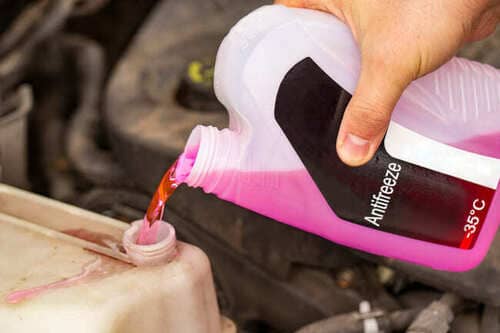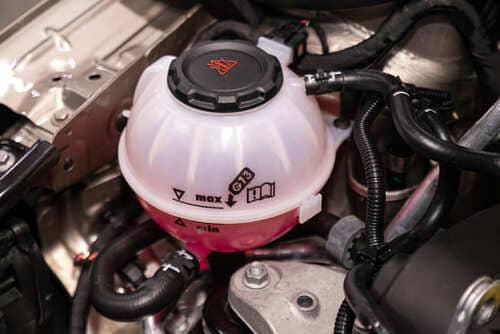A car's engine coolant, sometimes called antifreeze, is a liquid that circulates through a car's engine to prevent it from overheating. It absorbs the heat generated by the engine during operation and carries it to the radiator, where it is released into the air. Engine coolant protects the engine from freezing in cold weather. This is vital because a frozen engine block can crack and cause major damage. In short, engine coolant keeps your car's engine from getting too hot or too cold, both of which can cause serious problems.
How to top up engine coolant?

With the engine cool and the correct coolant in hand, ensure safety by wearing work gloves or using a cloth. Locate the coolant reservoir, unscrew its cap slowly to release any residual pressure, and then remove it. Using a funnel, add coolant gradually until it reaches the midpoint between the minimum and maximum marks. Securely tighten the cap to prevent leaks. Clean up any spills immediately and responsibly dispose of any leftover coolant, as it is toxic to humans, animals, and the environment.
Where to put coolant in the car?
Pop open the bonnet and identify the car's engine coolant reservoir. It'll typically be a translucent container, often white, with hoses connecting it to the radiator. Consult your car's manual for the exact location and recommended coolant type. The reservoir will have fill-level markings on its side. With a cold engine, the coolant should be between the minimum and maximum lines indicated. If it falls below the minimum, it's time for a top-up.
Do you add coolant to the radiator or reservoir?
You should pour antifreeze into the reservoir rather than directly into the radiator. The reservoir functions as a surge tank, storing extra coolant as it expands with heat and returning it to the system as the engine cools down. You can either use pre-mixed antifreeze or create a 50/50 blend of concentrated coolant and distilled water (check your owner's manual for the specific recommended ratio).
-
- Properties: Ready mixed
- Coolant manufacturer recommendation: G12
- Specification: G12
- Colour:
 red
red - Capacity [litre]:
![5 Capacity [litre]](https://cdn.pkwteile.de/uploads/icons/product/parameter/pkw/gl/423.png) 5
5 - Packing Type: Canister
- Operating temperature to [C°]: -35
- Observe technical data: +
- Condition: New
Details
Article № : 61-104 Antifreeze 61-104
5LCar parts maker: MA PROFESSIONAL(38)In stock
£ 8,38£ 1,68 for 1 litreincl. 20% VATMore -
In stock
£ 14,83incl. 20% VAT -
- Supplementary Article / Supplementary Info Info 2: with sensor, with cap
- Length [mm]:
![192 Length [mm]](https://cdn.pkwteile.de/uploads/icons/product/parameter/pkw/gl/203.png) 192
192 - Width [mm]: 196
- Height [mm]: 158
- Colour:
 grey
grey - Chemical Properties: Contains silicate
- for OE number: 5Q0121407A
- Condition: New
Details
Article № : 454009 Coolant expansion tank 454009
Car parts maker: NRFIn stock
£ 21,68incl. 20% VAT -
- Properties: Concentrate
- Coolant manufacturer recommendation: G12
- Product line: PROTECTIV 100
- Manufacturer recommendations: ASTM D3306, ASTM D1384, CUNA NC 956/16, SAE J1034 BS 6580-20, NF R 15601 type 1, DAIMLER DBL 7700.30, MAN 324-SNF, VAG TL-774 D, MTU MTL 5048, VAG TL-774 F
- Specification: G12
- Colour:
 yellow
yellow - Capacity [litre]:
![1 Capacity [litre]](https://cdn.pkwteile.de/uploads/icons/product/parameter/pkw/gl/423.png) 1
1 - Concentrate:
- Chemical Properties: Free of nitrite, Phosphate free, Amine free, Free of silicate, Borate free
- Weight [kg]: 1,12
- Packing Type: Bottle
- Condition: New
Details
Article № : 820734 Antifreeze 820734
1LCar parts maker: VALEO(1)In stock
£ 6,68£ 6,68 for 1 litreincl. 20% VATMore
How much coolant do I need?
It's difficult to give a specific amount of coolant needed for a standard passenger car because capacity varies from car to car. However, to give you a general idea, most standard passenger cars will probably need somewhere between 3 and 7 litres of coolant. This range covers a good proportion of typical car sizes.

Remember, this is only an estimate. For the most accurate information, consult your car's owner's manual, which will tell you exactly how much coolant your specific car needs.
How often do you have to top up coolant?
In a perfect scenario, you shouldn't need to top up your coolant very often at all. A properly functioning cooling system is a closed loop, meaning the coolant circulates and gets reused. However, there are a couple of reasons why you might need to add coolant:
- Leaks: This is the most common reason for needing more coolant. Even small leaks can slowly deplete the coolant level over time. If you find yourself needing to top up frequently, it's best to have a mechanic check your cooling system for leaks.
- Scheduled maintenance: Some manufacturers recommend coolant flushes and replacements at specific intervals, typically around 30,000 miles or every 5 years. This process involves draining the old coolant and refilling the system with fresh coolant.
Can you top up the coolant with water?
In an absolute pinch, you can add water to your coolant reservoir, but it's not ideal and should only be a temporary fix. Here's why:
- Reduced freeze protection: Antifreeze, protects your engine from freezing in cold weather. Water offers no such protection. If you top up with just water and then encounter freezing temperatures, your engine could crack, leading to major repairs.
- Boiling point issues: Coolant also raises the boiling point of the water in your cooling system. Straight water boils at a much lower temperature than the coolant, which could lead to overheating, especially in hot weather.
- Corrosion concerns: Some minerals in tap water can react with components in your car’s cooling system and cause corrosion. Distilled water is slightly better, but coolant is specifically formulated to prevent corrosion.
-
- Supplementary Article / Supplementary Info Info 2: with sensor, with cap
- Width [mm]: 190
- Height [mm]: 160
- Condition: New
Details
Article № : 454030 Coolant expansion tank 454030
Car parts maker: NRF(1)In stock
£ 15,58incl. 20% VAT -
- Properties: Ready mixed
- Coolant manufacturer recommendation: G12+, type D
- Temperature range from [°C]: -40
- Product line: Antifreeze 912+
- Manufacturer recommendations: SAE J1034, ASTM D3306, ASTM D4656, ASTM D4985, BS 6580: 1992, AFNOR NF R15-601, AS 2108, FFV Heft R443, CUNA NC 956-16, UNE 26361-88, NATO S 759, Ford WSS-M97B44-D, MB 325.3, RENAULT 41-01-001, GM 6277M, MAN 324 SNF, VAG TL-774 D, VAG TL-774 F, MAZDA, VOLVO
- Specification: G12
- Colour:
 red
red - Capacity [litre]:
![20 Capacity [litre]](https://cdn.pkwteile.de/uploads/icons/product/parameter/pkw/gl/423.png) 20
20 - Version: -40
- Temperature range to [°C]: +125
- Packing Type: Canister
- Condition: New
Details
Article № : PM0912-20 Antifreeze PM0912-20
20LCar parts maker: PEMCOIn stock
£ 30,88£ 1,54 for 1 litreincl. 20% VATMore -
- Supplementary Article / Supplementary Info: without coolant level sensor
- Supplementary Article / Supplementary Info Info 2: without lid
- Length [mm]:
![188,0 Length [mm]](https://cdn.pkwteile.de/uploads/icons/product/parameter/pkw/gl/203.png) 188,0
188,0 - Width [mm]: 172
- Height [mm]: 167,0
- Material: Plastic
- Colour:
 white
white - Additionally required articles (article numbers): CRB 96 000S
- Packaging height [cm]: 16,00
- Packaging length [cm]: 18,0
- Packaging width [cm]: 18,00
- Net Weight [g]: 424
- Condition: New
Details
Article № : CRT 21 000S Coolant expansion tank CRT 21 000S
Car parts maker: MAHLE ORIGINAL(1)In stock
£ 20,98incl. 20% VAT -
- Properties: Ready mixed
- Coolant manufacturer recommendation: G13
- Temperature range from [°C]: -40, +125
- Product line: AF13++, High-performance
- Manufacturer recommendations: SAE J1034, ASTM D3306, ASTM D4656, ASTM D4985, BS 6580:2010, AFNOR NF R15-601, (except for ra), VAG TL-774 G, VAG TL-774 J, CUMMINS CES 14603, DEUTZ DQC CC-14, IRIZAR, LIEBHERR Minimum, LH-01-COL3A, MAN 324 Type Si-OAT, MB 325.5, MB 325.6, SCANIA, SMART MB 326.0, Germany, FVV Heft R443, France NFR 15-601, Italy NC 956-16, Spain, UNE 26-361-88/1, NATO S-759
- Specification: G12
- Colour:
 violet
violet - Capacity [litre]:
![10 Capacity [litre]](https://cdn.pkwteile.de/uploads/icons/product/parameter/pkw/gl/423.png) 10
10 - Packing Type: Canister
- Chemical Properties: Contains silicate
- Condition: New
Details
Article № : MN4015-10 Antifreeze MN4015-10
10LCar parts maker: MANNOL(11)In stock
£ 25,18£ 2,52 for 1 litreincl. 20% VATMore
Can you put coolant in a hot car?
There are two main reasons why you shouldn't add coolant to a hot engine:
- Risk of burns: The cooling system is pressurised when the engine is hot. Opening the reservoir can release scalding hot coolant under pressure, causing serious burns. The coolant itself can be very hot, and even the reservoir cap can be too hot to touch safely.
- Engine damage: Sudden temperature changes caused by adding cold coolant to a hot engine can cause warping or cracking in engine parts, particularly the car cylinder head or engine block.
It's always best to wait until the engine cools down completely before checking or adding the coolant. This will help you avoid both personal injury and potential damage to your engine.
TOP products on the subject:




































